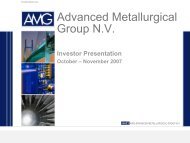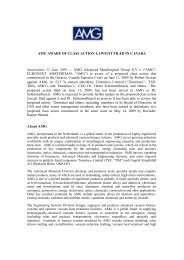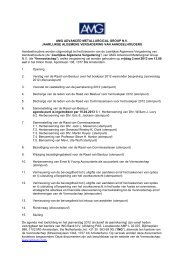C Si Ni Cr V Ti Ta Sc Li Sr Zr Fe Cu Zn Sn B Al Ce U Mn Mo Nb Sb
C Si Ni Cr V Ti Ta Sc Li Sr Zr Fe Cu Zn Sn B Al Ce U Mn Mo Nb Sb
C Si Ni Cr V Ti Ta Sc Li Sr Zr Fe Cu Zn Sn B Al Ce U Mn Mo Nb Sb
Create successful ePaper yourself
Turn your PDF publications into a flip-book with our unique Google optimized e-Paper software.
Depreciation methods, useful lives and residual values<br />
are reassessed at the reporting date.<br />
The depreciation of certain mining costs is linked to the<br />
production levels from the mine. Therefore, these assets<br />
are amortized using a units of production basis. Using that<br />
basis currently approximates a 7 year life of the mine. Other<br />
mining assets are depreciated on a straight-line basis<br />
ranging from 4-20 years, depending on the useful life.<br />
An item of property, plant and equipment is derecognized<br />
upon disposal or when no future economic benefits are<br />
expected from its use or disposal. Any gain or loss arising<br />
on derecognition of the asset (calculated as the difference<br />
between the net disposal proceeds and the carrying<br />
amount of the asset) is included in the income statement<br />
in the year the asset is derecognized.<br />
(f) Business Combinations and Goodwill<br />
Goodwill (negative goodwill) may arise on the acquisition<br />
of subsidiaries, associates and joint ventures.<br />
Business combinations from January 1, 2010<br />
Business combinations are accounted for using the<br />
acquisition method. The cost of an acquisition is measured<br />
as the aggregate of the consideration transferred,<br />
measured at acquisition date fair value and the amount<br />
of any non-controlling interest in the acquiree. For each<br />
business combination, the acquirer measures the<br />
non-controlling interest in the acquiree either at fair value<br />
or at the proportionate share of the acquiree’s identifiable<br />
net assets. Acquisition costs incurred are expensed and<br />
included in administrative expenses.<br />
When the Company acquires a business, it assesses the<br />
financial assets and liabilities assumed for appropriate<br />
classification and designation in accordance with the<br />
contractual terms, economic circumstances and pertinent<br />
conditions as at the acquisition date.<br />
If the business combination is achieved in stages, the<br />
acquisition date fair value of the acquirer’s previously<br />
held equity interest in the acquiree is remeasured to fair<br />
value at the acquisition date through profit or loss. Any<br />
contingent consideration to be transferred by the acquirer<br />
will be recognized at fair value at the acquisition date.<br />
Subsequent changes to the fair value of the contingent<br />
consideration which is deemed to be an asset or liability,<br />
will be recognized in accordance with IAS 39 either in<br />
profit or loss or as a change to other comprehensive<br />
income. If the contingent consideration is classified as<br />
equity, it should not be remeasured until it is finally settled<br />
within equity.<br />
Goodwill is initially measured at cost being the excess of<br />
the aggregate of the consideration transferred and the<br />
amount recognized for non-controlling interest over the<br />
net identifiable assets acquired and liabilities assumed.<br />
82 Notes to Consolidated Financial Statements<br />
If this consideration is lower than the fair value of the<br />
net assets of the subsidiary acquired, the difference is<br />
recognized in profit or loss.<br />
After initial recognition, goodwill is measured at cost less<br />
any accumulated impairment losses. For the purpose<br />
of impairment testing, goodwill acquired in a business<br />
combination is, from the acquisition date, allocated<br />
to each of the Group’s cash-generating units that are<br />
expected to benefit from the combination, irrespective<br />
of whether other assets or liabilities of the acquiree are<br />
assigned to those units. Where goodwill forms part of<br />
a cash-generating unit and part of the operation within<br />
that unit is disposed of, the goodwill associated with the<br />
operation disposed of is included in the carrying amount<br />
of the operation when determining the gain or loss on<br />
disposal of the operation. Goodwill disposed of in this<br />
circumstance is measured based on the relative values<br />
of the operation disposed of and the portion of the cashgenerating<br />
unit retained.<br />
If the Company completes a transaction that does not<br />
meet the definition of a business combination due to the<br />
acquiree not meeting the definition of a business, the<br />
Company:<br />
• identifies and recognizes the individual identifiable<br />
assets acquired and liabilities assumed; and<br />
• allocates the cost of the group of assets and liabilities<br />
to the individual identifiable assets and liabilities on the<br />
basis of their relative fair values at the date of purchase<br />
Acquisitions on or after January 1, 2005 prior to<br />
January 1, 2010<br />
For acquisitions on or after January 1, 2005 prior to<br />
January 1, 2010, goodwill represents the excess of the<br />
cost of the acquisition over the Company’s interest in<br />
the net fair value of the identifiable assets, liabilities and<br />
contingent liabilities of the acquiree. When the excess is<br />
negative (negative goodwill), it is recognized immediately<br />
in profit or loss.<br />
Fair value of identifiable assets is determined as follows:<br />
(i) Property, plant and equipment<br />
The fair value of property, plant and equipment recognized<br />
as a result of a business combination is based on market<br />
values. The market value of property is the estimated<br />
amount for which a property could be exchanged on<br />
the date of valuation between a willing buyer and a<br />
willing seller in an arm’s length transaction after<br />
proper marketing wherein the parties had each acted<br />
knowledgeably, prudently and without compulsion. The<br />
market value of items of plant and equipment is based on<br />
the quoted market prices for similar items.







